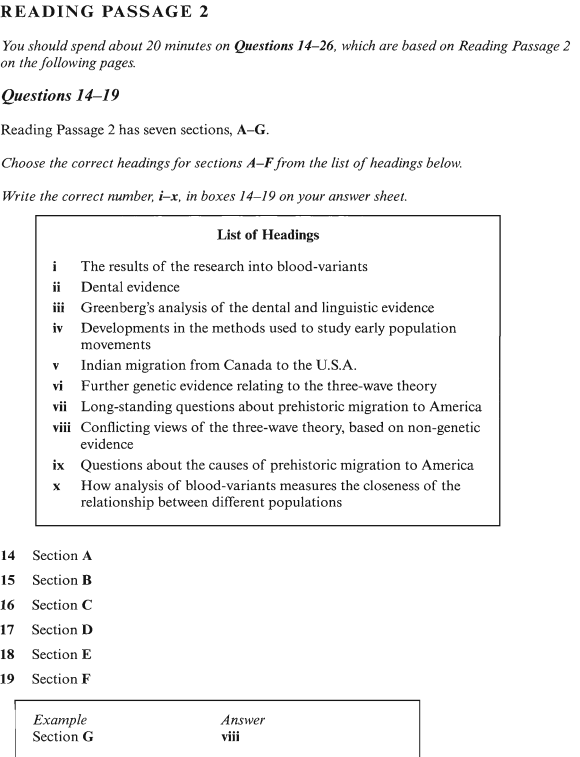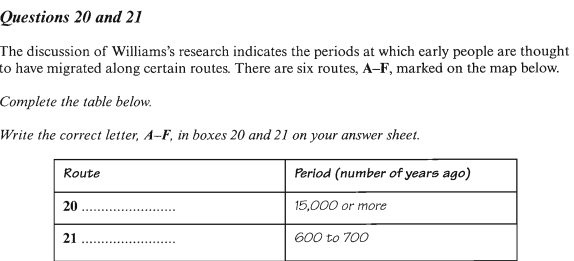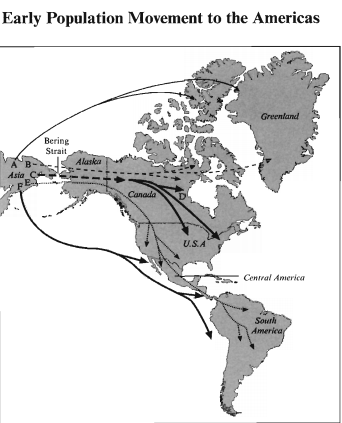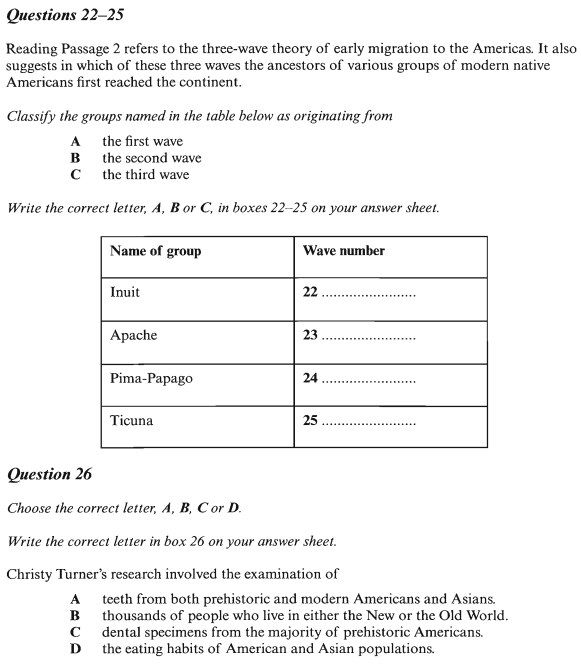剑桥雅思7阅读:Test3雅思阅读PASSAGE 2真题+答案+解析
发布时间:2020-12-15 关键词:剑桥雅思7阅读:Test3雅思阅读PASSAGE 2真题+答案+解析剑桥雅思7阅读:Test3雅思阅读PASSAGE 2真题+答案+解析,我们一起来看下吧。
Population movements and genetics

A
Study of the origins and distribution ofhuman populations used to be based onarchaeological and fossil evidence. Anumber of techniques developed sincethe 1 950s, however, have placed thestudy of these subjects on a sounder andmore objective footing. The best information on early population movements is now being obtained fromthe 'archaeology of the living body', theclues to be found in genetic material.
B
Recent work on the problem of whenpeople first entered the Americas is anexample of the value of these new
techniques. North-east Asia and Siberiahave long been accepted as the launching ground for the first humancolonisers of the New World'. But wasthere one major wave of migration acrossthe Bering Strait into the Americas, or several? And when did this event, orevents, take place? In recent years, newclues have come from research into genetics, including the distribution ofgenetic markers in modern NativeAmericans?.
C
An important project, led by the biological anthropologist Robert Williams,focused on the variants (called Gmalloypes) of one particular protein -immunoglobin G - found in the fluidportion of human blood. All proteins'drift', or produce variants, over the generations, and members of an interbreeding human population willshare a set of such variants. Thus, bycomparing the Gm allotypes of two different populations (e.g. two Indiantribes), one can establish their genetic'distance', which itself can be calibratedto give an indication of the length of timesince these populations last interbred.
D
Williams and his colleagues sampled theblood of over 5,000 American Indians inwestern North America during a twenty-year period. They found that their Gmallotypes could be divided into two
groups, one of which also correspondedto the genetic typing of Central and South ,American Indians. Other tests showed
that the Inuit (or Eskimo) and Aleut3 formed a third group. From this evidenceit was deduced that there had been threemajor waves of migration across the Bering Strait. The first, Paleo-lndian, wavemore than 1 5,000 years ago was ancestral to all Central and South American Indians. The second wave,about 14,000-12,000 years ago,brought Na-Dene hunters, ancestors ofthe Navajo and Apache (who only migrated south from Canada about 600or 700 years ago). The third wave,perhaps 10,000 or 9 ,000 years ago, sawthe migration from North-east Asia of groups ancestral to the modern Eskimoand Aleut.
E
How far does other research supportthese conclusions? Geneticist DouglasWallace has studied mitochondrial DNA4in blood samples from three widely
separated Native American groups: Pima-Papago Indians in Arizona, Maya Indiansonthe Yucatán peninsula, Mexico, and
Ticuna Indians in the Upper Amazonregion of Brazil. As would have beenpredicted by Robert Williams's work, allthree groups appear to be descendedfrom the same ancestral (Paleo-lndian)population.
F
There are two other kinds of research thathave thrown some light on the origins ofthe Native American population; theyinvolve the study of teeth and of
languages. The biological anthropologistChristy Turner is an expert in the analysisof changing physical characteristics inhuman teeth. He argues that tooth
crowns and rootsS have a high geneticcomponent, minimally affected by
environmental and other factors. Studiescarried out by Turner of many thousandsof New and Old World specimens, bothancient and modern, suggest that themajority of prehistoric Americans arelinked to Northern Asian populations bycrown and root traits such as incisor
shoveling (a scooping out on one or bothsurfaces of the tooth), single -rooted
upper first premolarsó and triple-rootedlower first molarsh.
According to Turner, this ties in with theidea of a single Paleo-lndian migrationout of North Asia, which he sets at before14 ,000 years ago by calibrating rates ofdental micro-evolution. Tooth analysesalso suggest that there were two latermigrations of Na-Denes and Eskimo-Aleut.
G
The linguist Joseph Greenberg has, sincethe 1950s, argued that all Native
American languages belong to a single'Amerind' family, except for Na-Dene andEskimo-Aleut - a view that gives credenceto the idea of three main migrations.
Greenberg is in a minority among fellowlinguists, most of whom favour the notionof a great many waves of migration toaccount for the more than 1,000
languages spoken at one time by American Indians. But there is no doubtthat the new genetic and dental evidenceprovides strong backing for Greenberg'sview. Dates given for the migrations
should nevertheless be treated with caution, except where supported by hardarchaeological evidence.
人口流动与遗传学
A
过去,对人类起源和分布的研究以考古学和化石证据为基础。然而,自19世纪50年代以来发展起来的大量技术,已经使这些学科的研究建立在一个更健全、更客观的基础上。关于早期人口流动的信息现在正从“活体考古学”中获得,即在遗传物质中发现的价值。
B
最近关于人类进入美洲的时间问题的研究就是这些新移民价值的一个例子
技术。东北亚和西伯利亚一直被认为是批人类殖民新大陆的出发地。”但是,穿越白令海峡进入美洲的主要移民浪潮是一次还是几次呢?这个事件,orevents,是什么时候发生的?近年来,遗传学研究提供了新的线索,包括基因标记在现代本土美国人中的分布。
C
生物人类学家罗伯特·威廉姆斯(Robert Williams)领导的一个重要项目,重点研究了一种特殊蛋白质——免疫球蛋白G的变体(称为Gmalloypes),这种蛋白质存在于人类血液的液体部分。所有的蛋白质在一代又一代的进化过程中都“漂移”或产生变异,而一个异种繁殖的人类群体的成员将会共享一套这样的变异。因此,通过比较两个不同种群(例如两个印第安部落)的转基因异型,可以建立他们的遗传“距离”,这本身可以校准,以给出这些种群最后杂交后的时间长度的指示。
D
威廉姆斯和他的同事对北美西部的5000多名印第安人进行了为期20年的血液采样。他们发现它们的Gmallotypes可以分为两种
其中一个基因类型也与中部和南部的美国印第安人有关。其他测试显示
因纽特人(或爱斯基摩人)和阿留申人组成了第三个族群。根据这一证据,我们推断曾有三次主要的移民浪潮穿过白令海峡。种是古印第安人,大约在1.5万年前,是所有中美洲和南美洲印第安人的祖先。第二波,大约在14000 - 12000年前,带来了纳瓦霍人和阿帕奇人的祖先纳德纳猎手(他们大约在600 - 700年前才从加拿大向南迁徙)。第三次移民浪潮大约发生在10000或9000年前,见证了现代爱斯基摩人和阿留申人的祖先从东北亚迁徙而来。
E
其他研究在多大程度上支持这些结论?遗传学家道格拉斯·华莱士研究了三个地区的线粒体DNA4in血液样本
分离的美洲土著群体:亚利桑那州的帕玛-帕帕戈印第安人,墨西哥尤卡坦半岛的玛雅印第安人
巴西亚马逊上游地区的Ticuna印第安人。正如罗伯特·威廉姆斯的研究所预测的那样,这三个族群似乎都来自同一个祖先(古印第安人)。
F
还有另外两种研究对美洲土著人口的起源提供了一些线索;它们包括牙齿和牙齿的研究
语言。生物人类学家克里斯蒂·特纳(christy Turner)是分析非人类牙齿变化生理特征的。他认为牙齿
冠和根具有高的遗传成分,受影响最小
环境和其他因素。特纳对数千个新、旧大陆的、既有现代的标本进行了研究,研究表明,大部分史前美国人的冠和根特征(如门牙)与北亚人有联系
铲(在牙齿的一个或两个表面上铲出),单根
上前磨牙和三根下磨牙。
根据特纳的说法,这与古印第安人离开北亚的一次迁徙有关,通过校准牙齿微观进化的速率,他把那次迁徙设定在1.4万年前。牙齿分析还表明,纳-丹尼斯和爱斯基摩-阿留德有过两次侧向迁移。
G
自20世纪50年代以来,语言学家约瑟夫·格林伯格(Joseph Greenberg)一直认为,所有的人都是土生土长的
除了纳- dene和爱斯基摩-阿留德之外,美国的语言都属于一个单一的“美洲人”语系,这一观点为三大主要移民的观点提供了证据。
格林伯格是语言学家中的少数人,大多数语言学家都赞同移民潮的观点,认为移民潮会造成1000多人
美洲印第安人曾经说过的语言。但毫无疑问,新的遗传学和牙科证据为格林伯格的观点提供了强有力的支持。迁徙的日期但应谨慎对待,除非有体质学证据支持。



READING PASSAGE 2
文章结构
体 裁:说明文
主 题:人类迁移及遗传学
段落概括
A概述人类利用遗传研究早期迁移的新技术。
B以人类迁移至美洲为例,借助新技术进行探索。
C详细解释利用GM抗免疫球蛋白研究人类的基因“距离”。
DWillams的三波移民理论。
E遗传学家对三波移民理论加以佐证。
F牙齿遗传分析同样支持三波人类移民理论。
G语言学家Greenberg的研究支持三波人类移民。




